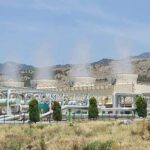Geothermal is an often-overlooked and even disregarded renewable energy resource. While new wind and solar energy projects garner headlines nearly every day, geothermal is rarely sighted in news feeds.
That could change in the future. In a report issued last year, the U.S. Department of Energy said geothermal electricity generation could increase more than 26-fold from today—reaching 60 GW of installed capacity by 2050. Furthermore, it said technology improvements could enable more than 17,500 geothermal district-heating installations nationwide, and 28 million U.S. households could realize cost-effective heating and cooling solutions through the use of geothermal heat pumps.
“There is enormous untapped potential for geothermal energy in the United States,” Rick Perry, Secretary of Energy at the time, said in a press release when the report was published. “Making geothermal more affordable can increase our energy options for a more diverse electricity generation mix and for innovative heating and cooling solutions for all Americans.”
Closed-Loop Geothermal Demonstration
One company that has made progress on new geothermal technology is GreenFire Energy. In June, the company completed the world’s first field-scale demonstration of closed-loop geothermal energy production. The demonstration was performed using an inactive well at the Coso geothermal field in Coso, California. The project was funded by a $1.48 million grant from the California Energy Commission, with additional support from Shell Oil, the Electric Power Research Institute (EPRI), and J-POWER—a large Japanese utility and EPRI member.
“The biggest thank you goes to the people at Coso, who were super supportive and helpful,” Joseph Scherer, CEO of GreenFire Energy, said as a guest on The POWER Podcast.
Scherer explained what was done: “At our Coso demo, we were able to insert a tube-in-tube heat exchanger 1,000 feet long into an existing geothermal well that couldn’t be used due to the high concentration of non-condensable gases, and we made over 1 MW of power, even though the project wasn’t really at full commercial scale. And with these results, we were able to validate the modeling we use to predict the performance of our various closed-loop solutions and a variety of geothermal resources.”
Understanding the Geothermal Resource Spectrum
There is actually a whole spectrum of geothermal resources. At one end of the spectrum are highly permeable resources, which have a lot of water and pressure. Conventional geothermal technology works fine for these resources. At the other end of the spectrum are impermeable resources and resources where the water is depleted. GreenFire Energy’s closed-loop technology is a solution for geothermal resources in the middle of that permeability water spectrum and at the impermeable dry-end of the spectrum, which is typically called “hot dry rock geothermal.”
“For resources in the middle of the permeability oil-water spectrum, where conventional geothermal systems are challenged often because the resource is still hot but has degraded somehow, our GreenLoop approach has a variety of immediate opportunities,” Scherer said. “And these are highly economic because a closed-loop system can be inserted into existing wells to retrofit them to extract heat, and there’s no need to drill the well—the well and all the related infrastructure is already there. And all the technical data about the well is readily available.”
The payback on such a retrofit is about one to three years, according to Scherer. “And that’s without counting the substantial savings of not having to plug an abandoned and unused well,” he said. “And we’re only harvesting the heat and typically not removing water from the resource or reducing the reservoir system pressure, so these retrofits can provide a roadmap for vastly expanding power production from the geothermal resource with a new purpose-drilled well system using the same GreenLoop technology. So, this middle range of that permeability water spectrum is just a huge opportunity for us right now.”
Down Bore Hydrogen Production
Scherer said another application that shows promise for GreenFire Energy’s technology is in hydrogen production. The company was asked by an oil and gas super major to investigate whether using geothermal heat down bore in its GreenLoop system could make “green” hydrogen more efficiently. “And happily, the answer is yes,” said Scherer.
He explained: “Since green hydrogen production is more efficient at high temperatures—and often benefits from high pressure—and since high temperatures and high pressures are free deep down in a geothermal resource, we can indeed substantially improve the efficiency of hydrogen production.” Furthermore, in order to be transported, hydrogen typically requires compression, which is expensive. However, when hydrogen is produced down bore at high pressure, it doesn’t require as much compression, which is an additional money-saving advantage.
The hydrogen production technology hasn’t been commercialized yet, but GreenFire Energy has the support to do so and expects that to be accomplished in the next two years. “Geothermal isn’t traditionally regarded as sexy, but hydrogen is. So, our plans to make hydrogen with geothermal energy makes GreenFire and geothermal sexy, right?” Scherer joked.
To learn more about geothermal energy and the work GreenFire Energy is doing, listen to the full interview on The POWER Podcast. Follow the links below to subscribe via your favorite platform or click on the SoundCloud player to listen now:
For more power podcasts, visit The POWER Podcast archives.
—Aaron Larson is POWER’s executive editor (@AaronL_Power, @POWERmagazine).









